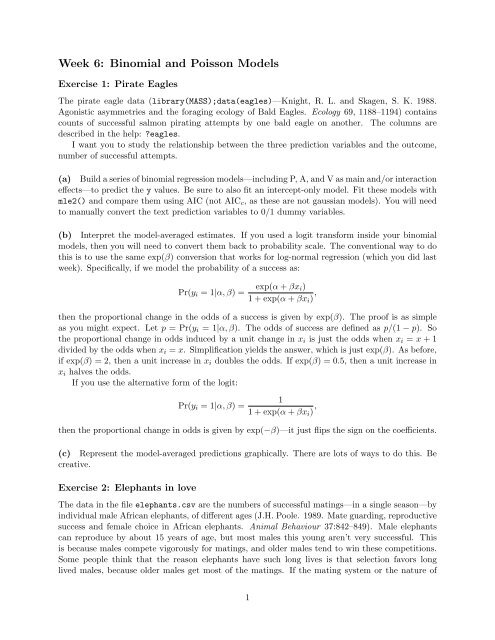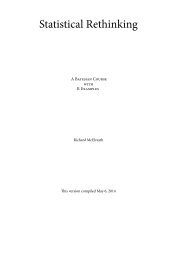Week 6: Binomial and Poisson Models
Week 6: Binomial and Poisson Models
Week 6: Binomial and Poisson Models
Create successful ePaper yourself
Turn your PDF publications into a flip-book with our unique Google optimized e-Paper software.
<strong>Week</strong> 6: <strong>Binomial</strong> <strong>and</strong> <strong>Poisson</strong> <strong>Models</strong><br />
Exercise 1: Pirate Eagles<br />
The pirate eagle data (library(MASS);data(eagles)—Knight, R. L. <strong>and</strong> Skagen, S. K. 1988.<br />
Agonistic asymmetries <strong>and</strong> the foraging ecology of Bald Eagles. Ecology 69, 1188–1194) contains<br />
counts of successful salmon pirating attempts by one bald eagle on another. The columns are<br />
described in the help: ?eagles.<br />
I want you to study the relationship between the three prediction variables <strong>and</strong> the outcome,<br />
number of successful attempts.<br />
(a) Build a series of binomial regression models—including P, A, <strong>and</strong> V as main <strong>and</strong>/or interaction<br />
effects—to predict the y values. Be sure to also fit an intercept-only model. Fit these models with<br />
mle2() <strong>and</strong> compare them using AIC (not AIC c , as these are not gaussian models). You will need<br />
to manually convert the text prediction variables to 0/1 dummy variables.<br />
(b) Interpret the model-averaged estimates. If you used a logit transform inside your binomial<br />
models, then you will need to convert them back to probability scale. The conventional way to do<br />
this is to use the same exp(β) conversion that works for log-normal regression (which you did last<br />
week). Specifically, if we model the probability of a success as:<br />
Pr(y i = 1|α, β) = exp(α + βx i)<br />
1 + exp(α + βx i ) ,<br />
then the proportional change in the odds of a success is given by exp(β). The proof is as simple<br />
as you might expect. Let p = Pr(y i = 1|α, β). The odds of success are defined as p/(1 − p). So<br />
the proportional change in odds induced by a unit change in x i is just the odds when x i = x + 1<br />
divided by the odds when x i = x. Simplification yields the answer, which is just exp(β). As before,<br />
if exp(β) = 2, then a unit increase in x i doubles the odds. If exp(β) = 0.5, then a unit increase in<br />
x i halves the odds.<br />
If you use the alternative form of the logit:<br />
Pr(y i = 1|α, β) =<br />
1<br />
1 + exp(α + βx i ) ,<br />
then the proportional change in odds is given by exp(−β)—it just flips the sign on the coefficients.<br />
(c) Represent the model-averaged predictions graphically. There are lots of ways to do this. Be<br />
creative.<br />
Exercise 2: Elephants in love<br />
The data in the file elephants.csv are the numbers of successful matings—in a single season—by<br />
individual male African elephants, of different ages (J.H. Poole. 1989. Mate guarding, reproductive<br />
success <strong>and</strong> female choice in African elephants. Animal Behaviour 37:842–849). Male elephants<br />
can reproduce by about 15 years of age, but most males this young aren’t very successful. This<br />
is because males compete vigorously for matings, <strong>and</strong> older males tend to win these competitions.<br />
Some people think that the reason elephants have such long lives is that selection favors long<br />
lived males, because older males get most of the matings. If the mating system or the nature of<br />
1
competition were different, selection might not favor males’ living so long. (I suppose one must<br />
ignore the female half of the species, which lives even longer than the male half, to take this theory<br />
seriously.)<br />
I want you to use a <strong>Poisson</strong> regression to study the relationship between age <strong>and</strong> mating success.<br />
(a)<br />
Plot number of matings (vertical axis) against age (horizontal axis).<br />
(b) Fit a <strong>Poisson</strong> model—matings ∼ age—using mle2(). Compare this model to the interceptonly<br />
model. Interpret the results, including the confidence intervals.<br />
(c)<br />
Plot the data again, <strong>and</strong> now overlay the predicted trend, using your estimated parameters.<br />
Exercise 3: Las salam<strong>and</strong>ras del norte<br />
The data in salam<strong>and</strong>ers.csv are abundances of salam<strong>and</strong>ers (Plethodon elongatus) from 47 plots<br />
in northern California (H.H. Welsh <strong>and</strong> A.J. Lind, 1995. Journal of Herpetology 29:198–210). You<br />
also are given the percent forest cover <strong>and</strong> forest age for each sampled site.<br />
(a)<br />
Plot the abundance against percent forest cover. Is the effect of cover approximately linear?<br />
(b) Model abundance as a linear function of percent cover, <strong>and</strong> compare this model to an alternative<br />
simpler model. Use a <strong>Poisson</strong> distribution for abundance in each case. Plotting your fit over<br />
the data, are you satisfied with this model or not?<br />
(c) Try adding another model to your comparison set: λ = α exp(βx i ). Compare this model to<br />
the other models you have fit, <strong>and</strong> also plot it over the data.<br />
(d) Finally, can you think of a biological reason that salam<strong>and</strong>ers might have been under-sampled<br />
in the more open sites? That is, imagine salam<strong>and</strong>ers are actually more abundant in the open sites<br />
than the data suggest. What might explain the mis-match between the data collected <strong>and</strong> the<br />
reality?<br />
2











